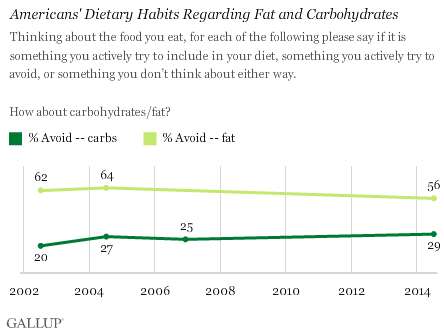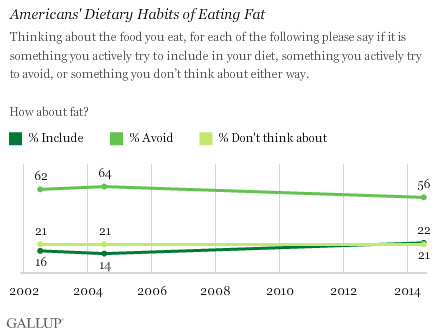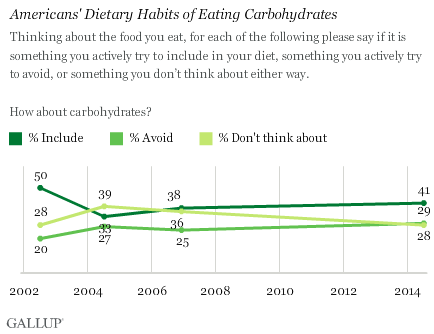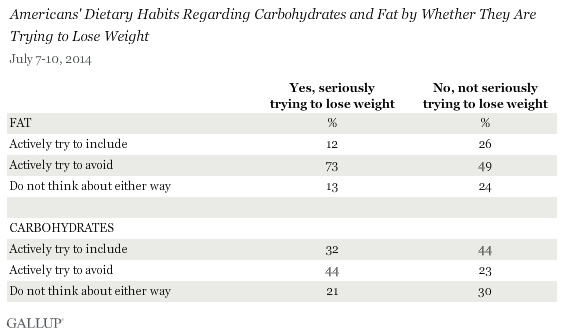WASHINGTON, D.C. -- Nearly twice as many Americans say they are actively trying to avoid fat in their diet (56%) as say they are actively avoiding carbohydrates (29%). However, fewer Americans are avoiding fat now than a decade ago.

These results are from the Gallup Consumption Habits survey, conducted July 7-10. With nearly half of Americans worrying about their weight "some" or "all" of the time, finding the right diet is an important challenge for many U.S. adults.
Two common types of diets on the market are low-fat and low-carb diets, and the two are often seen as competing with each other. Low-fat diets instruct users to avoid fatty foods, such as red meat, while low- or no-carb diets, popularized by the Atkins diet, allow high-fat foods in place of carbohydrates.
Both types of diets have been on the nutritional scene for decades, though low-fat diets enjoy more support in the form of U.S. government dietary guidelines. An opposing view asserts that processed carbohydrates -- not saturated fats -- are a key driver of weight gain, and this has gotten some scientific traction lately. Time magazine recently featured an article saying new research showed why "it's time to end the war [against fat]."
But despite the high-profile dietary debate, the public's attitudes about fats and carbohydrates have changed only marginally over the last decade, though perhaps they are now closer to the low-carb mentality. Twenty-two percent of Americans say they actively try to include fat in their diet, a percentage lower than for any of the 12 other foods Gallup measured in the poll. However, this percentage is slightly higher than in 2004 (14%), while the percentage who say they try to avoid fat is down since then.

More than four in 10 Americans (41%) say they try to include carbohydrates, and this is down slightly from the half who said so in 2002, but up from 33% in 2004, when the Atkins diet was fashionable.

Twenty-eight percent of Americans say they don't think about actively including or avoiding carbohydrates as part of their diet, down from what Gallup found in the mid-2000s. A smaller 21% say they don't think about whether they include or avoid fat in their diet.
Americans Trying to Lose Weight Strongly Avoid Fats
Twenty-nine percent of Americans say they are trying to lose weight. Of these, nearly three-fourths (73%) say they are actively trying to avoid fats. Slightly more than one in 10 (12%) say they are actively trying to include fats. However, individuals seeking to lose weight are more likely than the typical American to say they are avoiding carbohydrates (44%), suggesting many dieting Americans do not see an either/or proposition when it comes to determining how much fat and carbohydrates they should consume.

Bottom Line
Americans are still more likely to say they are avoiding fat rather than carbohydrates, but they are avoiding carbs more than they once were. Notably, the largest increase in the percentage who actively avoid carbohydrates occurred in 2004, coinciding with the general time the Atkins diet was most popular.
However, avoidance of fat is lower than it was a decade ago, perhaps reflecting new scientific research that is calling into question the supposed insalubrious effects of fat.
Individuals who say they are seriously trying to lose weight are more likely than other Americans to say they avoid both fats and carbohydrates, though fats are clearly the more pressing priority to exclude for dieters. Nonetheless, many dieters appear to take advice from both schools of thought, a reminder that dieters must customize and improvise to find the right balance for themselves.
Survey Methods
Results for this Gallup poll are based on telephone interviews conducted July 7-10, 2014, on the Gallup Daily tracking survey, with a random sample of 1,013 adults, aged 18 and older, living in all 50 U.S. states and the District of Columbia.
For results based on the total sample of national adults, the margin of sampling error is ±4 percentage points at the 95% confidence level.
Interviews are conducted with respondents on landline telephones and cellular phones, with interviews conducted in Spanish for respondents who are primarily Spanish-speaking. Each sample of national adults includes a minimum quota of 50% cellphone respondents and 50% landline respondents, with additional minimum quotas by time zone within region. Landline and cellular telephone numbers are selected using random-digit-dial methods. Landline respondents are chosen at random within each household on the basis of which member had the most recent birthday.
Samples are weighted to correct for unequal selection probability, nonresponse, and double coverage of landline and cell users in the two sampling frames. They are also weighted to match the national demographics of gender, age, race, Hispanic ethnicity, education, region, population density, and phone status (cellphone only/landline only/both, and cellphone mostly). Demographic weighting targets are based on the most recent Current Population Survey figures for the aged 18 and older U.S. population. Phone status targets are based on the most recent National Health Interview Survey. Population density targets are based on the most recent U.S. census. All reported margins of sampling error include the computed design effects for weighting.
In addition to sampling error, question wording and practical difficulties in conducting surveys can introduce error or bias into the findings of public opinion polls.
For more details on Gallup's polling methodology, visit www.gallup.com.
